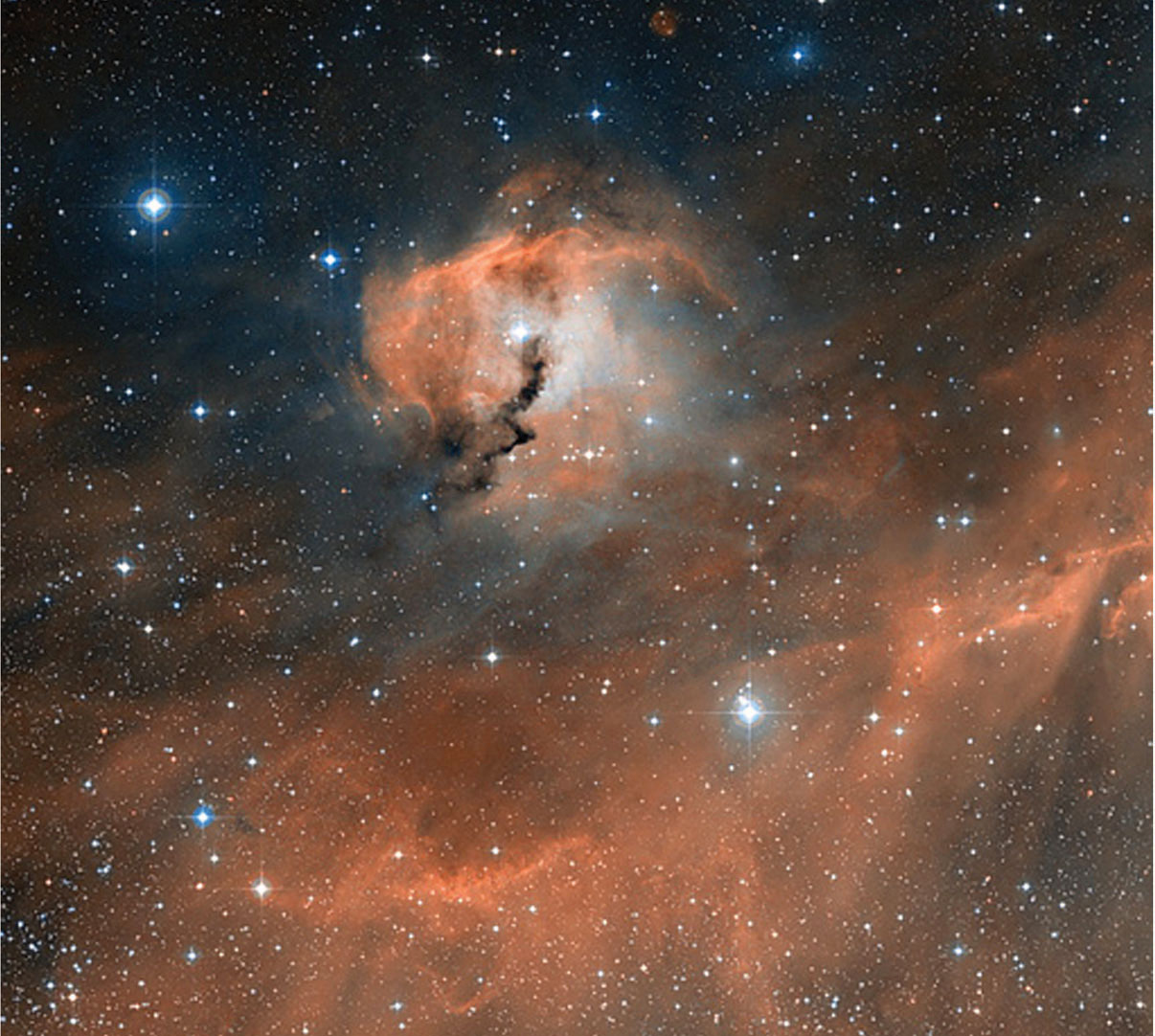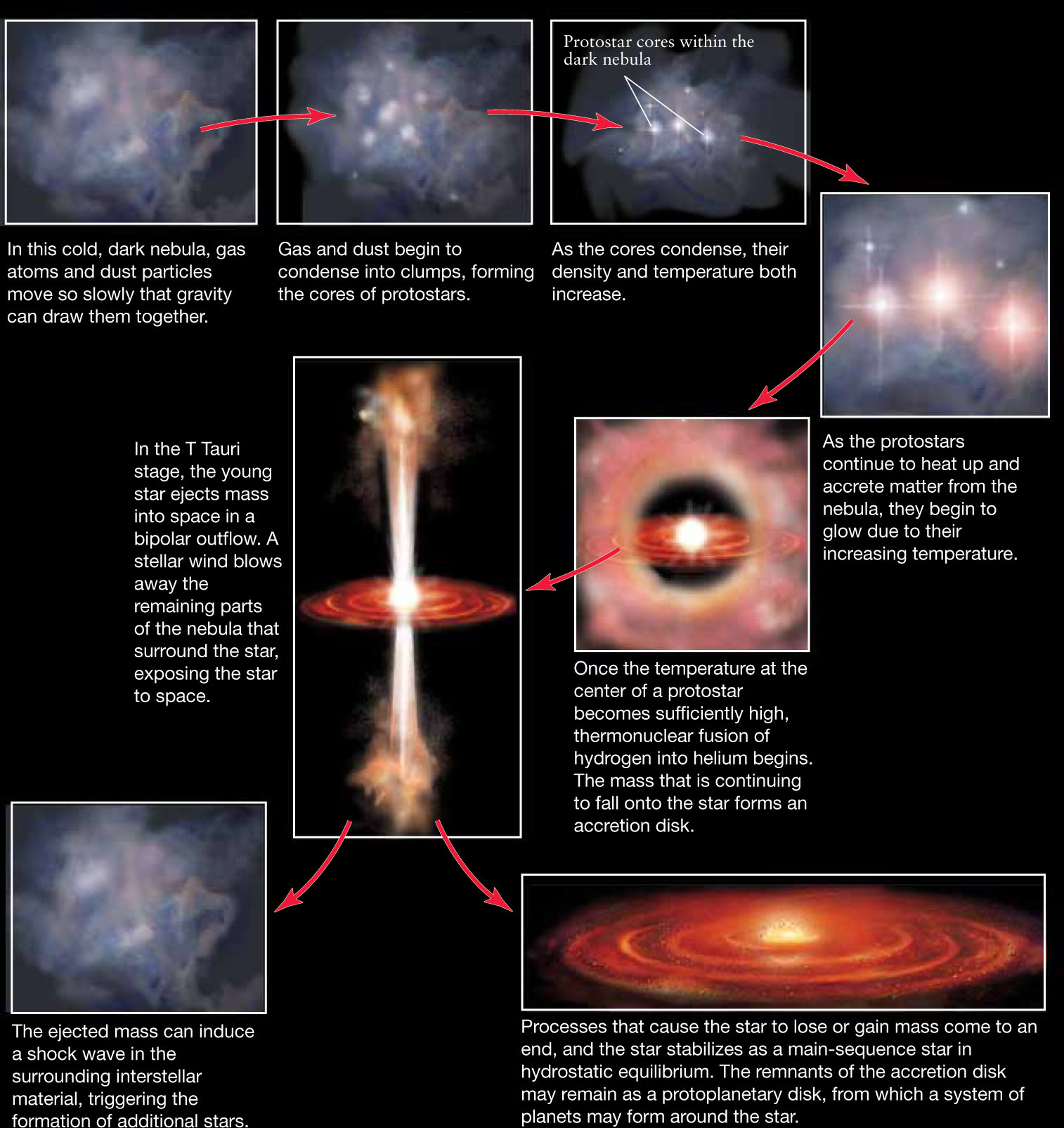18-8 Supernovae compress the interstellar medium and can trigger star birth
Spiral arms are not the only mechanism for triggering the birth of stars. Presumably, anything that compresses interstellar clouds will do the job. The most dramatic is a supernova, caused by the violent death of a massive star after it has left the main sequence. As we will see in Chapter 20, the core of the doomed star collapses suddenly, releasing vast quantities of particles and energy that blow the star apart. The star’s outer layers are blasted into space at speeds of several thousand kilometers per second.
Supernova Remnants and Star Formation
Astronomers have found many nebulae across the sky that are the shredded funeral shrouds of these dead stars. Such nebulae, like the one shown in Figure 18-26, are known as supernova remnants. Many supernova remnants have a distinctly circular or arched appearance, as would be expected for an expanding shell of gas. This wall of gas is typically moving away from the dead star faster than sound waves can travel through the interstellar medium. As we saw in Section 18-7, such supersonic motion produces a shock wave that abruptly compresses the medium through which it passes. When a gas is compressed rapidly, its temperature rises, and this temperature rise causes the gas to glow as shown in Figure 18-26.

 The Canis Major R1 Association These luminous arcs of gas are studded with numerous young stars. Both the luminous arcs and the young stars within can be traced to the same source—a supernova explosion. The shock wave from the supernova explosion is exciting the gas and making it glow; the same shock wave also compresses the interstellar medium through which it passes, triggering star formation.
The Canis Major R1 Association These luminous arcs of gas are studded with numerous young stars. Both the luminous arcs and the young stars within can be traced to the same source—a supernova explosion. The shock wave from the supernova explosion is exciting the gas and making it glow; the same shock wave also compresses the interstellar medium through which it passes, triggering star formation.

 A Supernova Remnant This composite image shows Cassiopeia A, the remnant of a supernova that occurred about 3000 pc (10,000 ly) from Earth. In the roughly 300 years since the supernova explosion, a shock wave has expanded about 3 pc (10 ly) outward in all directions from the explosion site. The shock wave has warmed interstellar dust to a temperature of about 300 K (Spitzer Space Telescope infrared image in red), and has heated interstellar gases to temperatures that range from 104 K (Hubble Space Telescope visible-light image in yellow) to 107 K (Chandra X-ray Observatory X-ray image in green and blue).
A Supernova Remnant This composite image shows Cassiopeia A, the remnant of a supernova that occurred about 3000 pc (10,000 ly) from Earth. In the roughly 300 years since the supernova explosion, a shock wave has expanded about 3 pc (10 ly) outward in all directions from the explosion site. The shock wave has warmed interstellar dust to a temperature of about 300 K (Spitzer Space Telescope infrared image in red), and has heated interstellar gases to temperatures that range from 104 K (Hubble Space Telescope visible-light image in yellow) to 107 K (Chandra X-ray Observatory X-ray image in green and blue).
When the expanding shell of a supernova remnant slams into an interstellar cloud, it compresses the cloud, stimulating star birth. This kind of star birth is taking place in the stellar association seen in Figure 18-27. This stellar nursery is located along reddish luminous arcs of gas extending about 30 pc (100 ly) in length that is presumably the remnant of a supernova explosion. (In fact, these arcs are part of an almost complete ring of glowing gas). Since a supernova remnant does not last very long, this interpretation requires that the stars triggered by the supernova are young. But are the stars young? Spectroscopic observations of stars along this arc reveal substantial T Tauri activity. This activity results from young protostars undergoing mass loss in their final stages of contraction before they become main-sequence stars.
Our Sun may have formed in association with a number of other stars
A supernova a few light-years away may have triggered the formation of our own Sun. Supernovae produce a variety of radioactive atomic nuclei, including some that are not produced in any other way. These nuclei are dispersed into space by the explosion, and act as telltale signs of their supernova origin. Traces of these telltale nuclei have been discovered in meteorites that have fallen to Earth. Since meteorites formed very early in the history of our solar system (see Section 8-3), this suggests that a supernova occurred nearby when our solar system was very young. Detailed modeling suggests this interpretation is plausible, with a supernova about 15 ly away triggering the collapse of a cloud that became our solar system.
Many other processes can also trigger star formation. For example, a collision between two interstellar clouds can create new stars. Compression occurs at the interface between the two colliding clouds and vigorous star formation follows. Similarly, stellar winds from a group of O and B stars may exert strong enough pressure on interstellar clouds to cause compression, followed by star formation. (This process is similar to the one depicted in Figure 18-25.)
Star Birth in Perspective
Our understanding of star birth has improved dramatically in recent years, primarily through infrared- and millimeter-wavelength observations. The Cosmic Connections figure summarizes our present state of knowledge about the formation of stars.
COSMIC CONNECTIONS
How Stars Are Born
If a clump of interstellar matter is cold and dense enough, it will begin to collapse thanks to the mutual gravitational attraction of its parts. If the clump is massive enough, it will evolve into a main-sequence star through the sequence of events shown here.

Nevertheless, many puzzles and mysteries remain. One problem is that different modes of star birth tend to produce different percentages of different kinds of stars. For example, the passage of a spiral arm through a giant molecular cloud tends to produce an abundance of massive O and B stars. In contrast, the shock wave from a supernova seems to produce fewer O and B stars but many more of the less massive A, F, G, and K stars. We do not yet know why this is so.
Despite these unanswered questions, it is now clear that star birth involves mechanisms on a colossal scale, from the deaths of massive stars to the rotation of an entire galaxy. In many respects, we have just begun to appreciate these cosmic processes. The study of cold, dark stellar nurseries will be an active and exciting area of astronomical research for many years to come.
In the chapters that follow, we will learn that the interstellar medium is both the birthplace of new stars and a dumping ground for dying stars. At the end of its life, a star can shed most of its mass in an outburst that enriches interstellar space with new chemical elements. The interstellar medium is therefore both nursery and graveyard. Because of this intimate relationship with stars, the interstellar medium evolves as successive generations of stars live out their lives. Understanding the details of this cosmic symbiosis is one of the challenges of modern astronomy.
CONCEPT CHECK 18-9
Several processes have been considered in this chapter that initiate star formation in clouds. What do they have in common?
Protostars begin to form when gravity overwhelms a gas cloud’s internal pressure. This is initiated when an external process compresses the cloud.